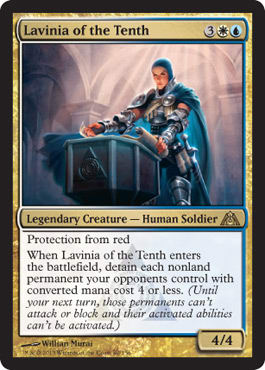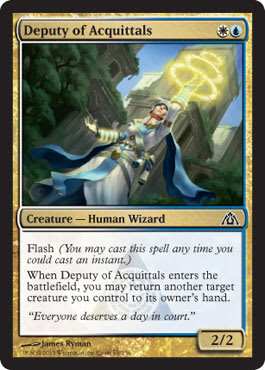I recently played in Pro Tour Dragon’s Maze in San Diego. There were two formats: Return to Ravnica–block Draft and Return to Ravnica Block Constructed. After the full spoilers for Dragon’s Maze came out, I started cranking out proxies for various Block decks to test. Many hours of many days were devoted to testing those decks, making adjustments, designing new decks, doing more testing, and repeating. On the Monday before the Pro Tour, that process came screeching to a halt. That day was the first day I could do full-block Drafts on Magic Online. What followed were three days of intensive drafting and drafting strategy discussions with friends and allies.
It was a process of failing over and over until I found my Draft. Once I found what worked for me, I honed it and perfected it and eventually parlayed that into a winning record in Draft at the Pro Tour.
Given how fast Draft formats change with new sets constantly being introduced and the fact that most people don’t have infinite time and money for drafting, I have long been a proponent of finding a few archetypes to specialize in. For Pro Tour Dragon’s Maze, this was more important than usual. Not only did I have a mere three days to try to master the format before the Pro Tour, but the number of good, viable archetypes in this format are way more than a typical Draft format.
Finding My Draft: Day One
If I was measuring my success in Draft by wins and losses, my first day of drafting full Return to Ravnica–block Draft was a complete disaster. I did five 8–4 Drafts, and I suffered five first-round losses. Part of the reason for this was that I was trying out a bunch of different strategies. I tried drafting a pretty even three-colored deck first, and I lost to a five-colored deck with a more powerful late game. I tried drafting a fast two-colored Selesnya deck, and I lost to a four-colored deck with a better late game. I tried drafting a powerful five-colored deck with eleven Guildgates and three Blast of Genius, and I lost to a four-colored deck with a better early game. In my next Draft, my first two picks were a Blood Baron of Vizkopa and a Tithe Drinker, so I drafted a two-colored Orzhov deck with a lot of extort. After that failed in Round 1, I consulted with my main Magic confidantes Rob Dougherty and Rada Rudyak.
Based on my discussions with them, I next drafted a hyper-aggressive, two-colored Gruul deck. This gave me slightly better results. I lost a close Game 1. Then, I won an epic Game 2, in which I overcame several very difficult situations. The biggest problem, though, was that he played Sphere of Safety and several other enchantments each game. It wasn’t that it made it impossible for me to win those games, it was that it really punished my clock. I used scads of clock paying a ton of mana for the Sphere every turn, and I took longer to win games for several Sphere-related reasons, including having to take turns off from attacking whenever I decided to cast something. Yet, since I didn’t have a similar deck, his clock was robust in comparison. As a result, I timed out in Game 3 despite having an excellent draw and a big early advantage. This is an example of R&D’s priorities: They design cards for the tabletop, not for the online game. I think this is totally fine; it’s just annoying when I’m playing online and I have to pay the price for it.
Finding My Draft: Day Two
Sure, I had just lost in Round 1 of five straight Drafts, but I’ve learned to stay focused on what my actual goals should be. I’ve learned not to care about any given MTGO Draft; this was an important learning process. If I wanted to be ready for the Pro Tour, I needed to be able to power through any number of losses to accomplish my learning goals. After my tepid success with two-colored aggro, I decided to try it again.
Which two colors to play were instantly decided for me when I opened up Lavinia of the Tenth. Let me start by saying that if my experience in this Draft taught me nothing else, it’s that if I open up Lavinia, I should take her over any other possible card in the pack. I played her in each of my first four games, and each time, the game ended in my favor by the next turn—though it was sometimes due to concession. My opponent in the finals offered me a split, but I refused in large part because I was hoping to play some games against a tough opponent and in which I didn’t draw Lavinia in order to form a better idea of how good my deck was.
Sure enough, I didn’t draw Lavinia in either game; yet, I still took down the finals 2–0. This 6–0 performance was great for my confidence after a disastrous first day of drafting, and it seemed to be something I could build on.
Takeaway
Rightfully so, most people feel that Draft is almost entirely about judging the relative power level of cards. Most people also realize drafting is about ranking the relative power level of various archetypes based on the power level of the individual cards available in those archetypes. Last, most people realize the importance of judging what archetype is most available to you in the seat you’re sitting in. For many, Draft consists of just those three things: card evaluation, archetype evaluation, and seat awareness.
I think most people are missing a very important factor: self-evaluation. This is where the “finding your Draft” comes in. It’s important to find out what you’re good at drafting and playing, whether it’s just because of the power level, a style you’re comfortable with, or just finding archetypes that are well suited to your skill set.
My performance with the W/U deck was in such stark contrast to my first five Drafts that I immediately decided that:
- W/U was powerful.
- I was comfortable drafting and playing W/U.
- I was good at drafting and playing W/U.
Follow-Up
Of course, my sample size was small, and time was running out, so I needed to immediately pursue this further. Among other things, I needed to find out whether W/U was always powerful no matter what the players around me were doing or whether it only powerful when it was coming to me hard.
Obviously, it would have been nice to be a master of every possible RTR Draft archetype before the PT, but that clearly wasn’t going to be possible. Among other things, there are way more viable archetypes than usual. Not only are there ten guilds clearly designed to be drafted, but the block is clearly designed for drafting every possible three-, four-, and even five-colored combination. Even if I managed to fit in twenty-four Drafts, one of each combination of colors, where would that get me? Not only would that fail to give me a chance to actually become good at any one of those twenty-four possibilities, but what about multiple archetypes within those color combinations? I clearly didn’t have time to prepare for drafting at the Pro Tour in any kind of comprehensive fashion. Frankly, I think this format is so diverse that by the time anyone can start making such a claim, a new set will be released and it will be time to start over.
This definitely doesn’t mean that I wouldn’t be able to prepare sufficiently to be successful of course. For starters, my opponents would all be dealing with the same problems that I was facing, though some would have done more Drafts than I had, and some fewer. The important part would be for me to use those Drafts I was able to do efficiently to find a Draft strategy that would work for me.
I managed to do four more MTGO Drafts before I left for the PT. I never lost in the first round again. In each of those Drafts, I drafted W/U, but in each of them, I ended up splashing a third color. Forcing a two-colored archetype in RTR-block Draft is even better than in most other blocks. This is in part because people are frequently playing three or more colors and just drafting the best card in each pack, meaning that your chances of having a bomb in your colors passed to you because the players around you are playing those colors is quite slim. Thus, trying to read a Draft to determine what your colors should be is often just a lost cause. The other reason forcing colors works so well in this format is that it’s so easy to splash a third color if you need or want to.
The Payoff
Based on those ten MTGO Drafts, I was able to head to the PT confident that I had found my Draft. I had a plan that worked for me. Day 1, it worked as well as I could possibly have hoped—I drafted an aggressive W/U deck with a splash of red for Blast of Genius, Martial Glory, and three creatures costing 4 or more. I managed to snag two Izzet Guildgates and an Azorius Guildgate to smooth my mana, though I had to use very high picks on them. In both of my Drafts, I rarely picked up a relevant Guildgate later than around fifth or sixth pick. I went 3–0, winning my first Draft and propelling myself briefly to near the top of the standings. A 6–2 record on Day 1 landed me comfortably into Day 2, which started with another three-round Draft.
I stuck with my plan and ended up with another W/U deck, this time splashing red for Skyknight Legionnaire, Mercurial Chemister, Fortress Cyclops, Blast of Genius, and Gleam of Battle. I was almost as happy with this deck as with my first one, but alas, my results were inferior. In the first round, I ran into some incredible misfortune: Pack Rat. After I overcame a midgame Pack Rat in Game 1, I lost both games two and three to a turn-two Pack Rat. Sigh . . . After losing a tough second round, I managed to salvage a 1–2 Draft with a win over fellow Hall of Famer Bram Snepvangers. Given the Pack Rat problem and only managing ten practice Drafts, I can’t be too upset with my 4–2 performance in Draft at the PT. The key for me was finding my Draft. By quickly finding a strategy that worked for me, I was able to practice and refine it and then go into the Draft confident that I had a plan that would work for me. Have you found your Draft?


























